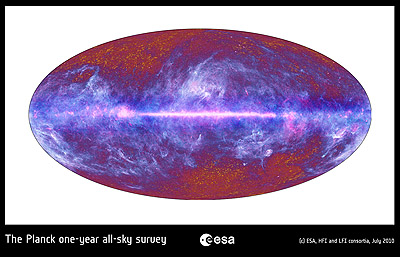|
|
 The first map of the microwave sky produced by ESA's Planck spacecraft. The blue areas of the map are emission from gas and dust in
our Galaxy – the line through the middle of the map is the Galactic plane.
The reddish areas towards the north and south poles of the map show the cosmic microwave background – its reddish "colour" (obviously the colours are artificial, as this map is not in visible light) indicates that it is at a lower temperature than the Galactic emission. The subtle variations in the microwave background are currently our most productive source of data on cosmology.
The first map of the microwave sky produced by ESA's Planck spacecraft. The blue areas of the map are emission from gas and dust in
our Galaxy – the line through the middle of the map is the Galactic plane.
The reddish areas towards the north and south poles of the map show the cosmic microwave background – its reddish "colour" (obviously the colours are artificial, as this map is not in visible light) indicates that it is at a lower temperature than the Galactic emission. The subtle variations in the microwave background are currently our most productive source of data on cosmology.
|
Summary of Lecture 11 – The First 400000 Years
- In the first 10-35 seconds of the Big Bang model, the Universe is born as a sea of very high-energy
elementary particles:
- current theories of particle physics imply that the physical
laws were different in the very early universe:
- our present four forces (strong, electromagnetic, weak,
gravity) were combined into one superforce;
- particles and antiparticles existed in equal numbers,
constantly annihilating into energy and being recreated from
energy (E = mc2);
- there were no protons or neutrons, but only the elementary
particles that we call quarks (together with
electrons, neutrinos, photons, etc.);
- the transition from this very high energy physics to 'our' physics
powered a brief period of very rapid expansion
(inflation);
- inflation explains three issues that are hard to explain in the
original big bang model:
- the horizon problem – the fact
that widely separated regions on the sky have the same
microwave background temperature, even though it looks as
though they could never have exchanged photons;
- the flatness problem – the fact
that the geometry of the universe seems to be very close to
flat, though there is no theoretical reason for this;
- the small variations in the density of the
very early universe, which are the "seeds" from which the
galaxies we see today will eventually grow;
- inflation solves these problems because:
- our visible universe originated in an extremely
tiny region of the pre-inflation universe,
which had time to stabilise its temperature before
inflation started;
- the inflationary expansion is so rapid
that it flattens out pre-existing
curvature;
- tiny random quantum fluctuations expand in
size during inflation to become
marginally denser regions of the early universe;
- After about 1/10000 second protons and neutrons form:
- for reasons that are not yet understood, there is a slight
asymmetry between matter and antimatter, so the
resulting particle-antiparticle annihilations leave
some protons and neutrons (but no antiprotons or antineutrons) left over;
- because the neutron is slightly heavier, there are about five
times as many protons as neutrons;
- because free neutrons are unstable, this ratio will increase
with time as the neutrons convert to protons (emitting an electron
and a neutrino).
- After about 1 second the protons and neutrons start to
combine to form deuterium (2H):
- initially this just gets broken up again, but after about 100 seconds it starts to build up as the universe cools;
- the deuterium then combines with a proton or neutron to form
3H (tritium) or
3He;
- these in turn collide to make normal helium,
4He;
- eventually almost all the remaining neutrons are incorporated into
4He:
- for every 2 neutrons there are about 14 protons (allowing for
neutron decays);
- therefore for every helium nucleus there are 12 hydrogen
nuclei: the universe is about 25% helium by weight (with
traces of deuterium and helium-3 left over, and a bit of
7Li formed by colliding 4He with
3He);
- the lack of stable nuclei with atomic mass of 5 or 8 stops the process
from continuing to heavier elements.
- The Universe is now a mixture of hydrogen and helium nuclei, electrons,
photons, neutrinos and dark matter:
- the photons interact vigorously with the charged
particles, producing a thermal (blackbody)
distribution (the early universe is hot and dense);
- but after about 380,000 years, when the temperature
is about 3000 K, the electrons combine with nuclei to
produce neutral atoms:
- these do not interact so readily with photons;
- the Universe is now transparent and pervaded by
a sea of blackbody radiation;
- this radiation, redshifted to 2.7 K by the
expansion of the Universe, can now be detected as the
cosmic microwave background radiation;
- the tiny density variations produced in
inflation can be
seen as temperature variations in the CMB:
- higher density implies slightly greater gravitational
attraction, so these regions collect more mass and
become denser still;
- eventually they give rise to galaxies, stars, us...
Web links
Go back to main page
Go on to Summary for Lecture 12
|
Hicks Building, Hounsfield Road, Sheffield S3 7RH, UK
|